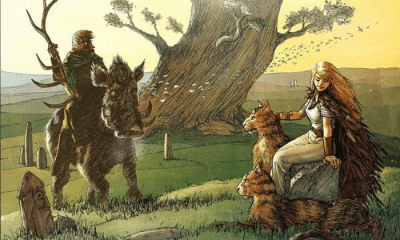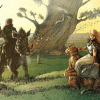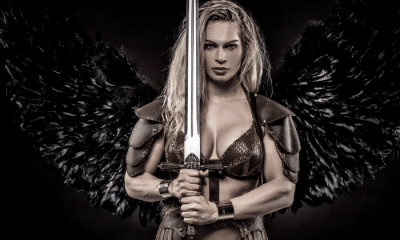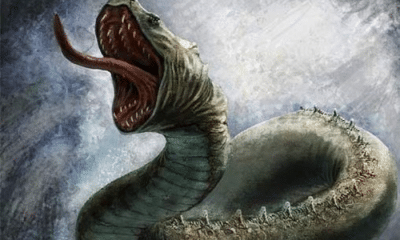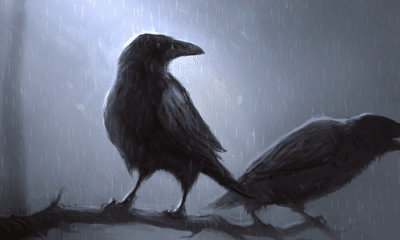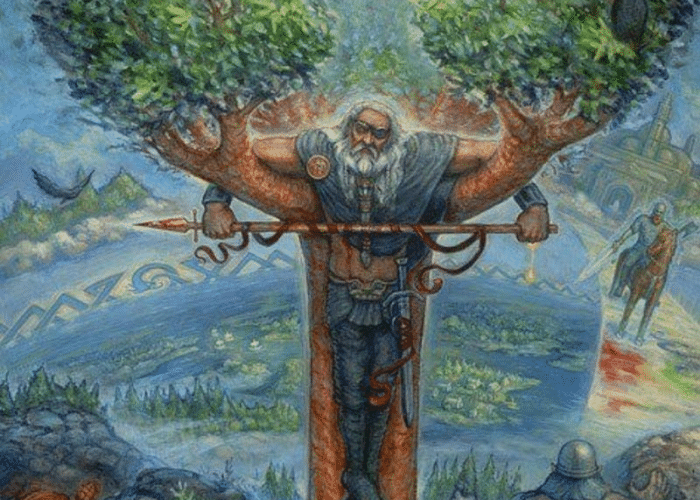
Norse
Odin’s Discovery of the Runes
The Norse god Odin was known for constantly seeking greater knowledge. Here’s the story of how he made the ultimate sacrifice to learn a lost form of magical power.
Odin was the god of war and kingship, but he was also a god of knowledge and magic.
He was constantly seeking more wisdom and new information. He travelled the Nine Worlds to learn all that he could and often went to great lengths to find secret knowledge.
He was never satisfied, however, and was always pushing himself further to become the wisest sage alive.
In his most dramatic act, Odin made the ultimate sacrifice to learn a secret that was hidden deep in the well of fate. To learn the magic of the runes, Odin gave himself as a human sacrifice.
The story of how Odin discovered the runes provides a vivid image not only of the god, but of ritual practices that were actually performed in the Norse world.
Odin’s Sacrifice to Himself
Odin was on a constant hunt for knowledge and had already done many things in his quest for now information.
He had stolen the Poetry of Mead in the form of an eagle and visited the realm of Hel to learn about Ragnarök from a dead seer.
He was constantly getting news from his two ravens, Huginn and Muninn, who flew throughout the Nine Worlds to bring back every bit of information they could find.
He had also made a great sacrifice to learn more. When Mímir had said that something must be given up to drink from his well and acquire its knowledge, Odin had plucked out his own right eye and thrown it into the water to get just a sip.
There was still more to learn, however.
Odin watched the Norns, knowing that they knew more than anyone else about the world. The three goddesses wove the strands of fate among Yggdrasil’s roots, but rarely shared their knowledge with others.
He knew that another great sacrifice would be required to learn more. He decided to make the greatest sacrifice he could to get a glimpse of the Norns’ wisdom.
Odin hanged himself from the branches of Yggdrasil as a human sacrifice. He made it a blood sacrifice by piercing himself with a spear.
For nine days and nights the god hung on the tree. From his position in the branches he looked down into the Well of Urd by which the Norns wove fate and waited for its mysteries to be revealed.
Some of the creatures that lived in the World Tree’s branches approached him during his ordeal. The eagle in the tree’s bows and the squirrel Ratatoskr watched his suffering but he forbade them from bringing him any food or water.
The Well of Urd slowly began to reveal things to him. The image of an ancient god taught him nine magical songs, but he remained in the tree knowing that there was more to see.
He learned nine words of great power but continued his sacrifice.
At the end of the ninth day he was barely clinging to life. Just before the moment of death, his sacrifice was accepted and the well showed him the runes.
The lost alphabet was more than just a system of writing. Each symbol carried with it magic and when used in the correct way the runes could be used to weave powerful spells.
Odin screamed as the knowledge entered his mind and fell from the tree. By offering the ultimate sacrifice, himself, he had learned the greatest magical power in the universe.
My Modern Interpretation
One of the primary sources for the story of Odin’s sacrifice, the Poetic Edda, describes it as “given to Odin, myself to myself.”
Odin’s sacrifice was not an arbitrary act. It followed the same rituals as the sacrifices the Norse people gave to their god.
Norse religion practiced many sacrifices of both humans and animals to appease the gods and win their favor. Odin was known for being bloodthirsty, so his sacrifices were often particularly brutal.
Victims were often both stabbed and hanged in Odin’s sacrifices. This fulfilled the god’s requirement for blood and made sure that the death was prolonged and highly visible for maximum effect.
Those sacrificed in Odin’s rituals were also not criminals or captives. Nobles and brave warriors offered themselves in the god’s honor to earn a place in Valhalla and honor for their families.
Odin’s act was therefore more than just a common sacrifice. It was truly a sacrifice to himself.
Odin was the most noble sacrifice possible. He offered himself to further his own power and knowledge.
The god took the role of victim to an extreme, as well. While actual victims who lived for a time might have been given water to ease their pain somewhat, Odin refused to take any form of comfort.
Although he was a god, Odin was not necessarily immortal. The gods were fated to die at Ragnarök, making it clear that extreme circumstances could kill them. Odin had also already been proven vulnerable by permanently losing his eye in an earlier sacrifice.
The nine days and nights that Odin hung on the World Tree nearly pushed him to the point of true death. In fact, some interpretations of the Poetic Edda come to the conclusion that some part of Odin did die on the tree.
The Poetic Edda describes the revelation of the runes in terms of both death and of rebirth. The pain of his hanging is followed by images of having “quickened and flourished, sprouted and throve.”
This imagery of rebirth is taken to mean that a part of Odin died to give birth to the more exalted, powerful god who came off the tree with the lost knowledge of runic magic.
In Summary
Odin spent a great deal of time and energy in Norse mythology to learn all that he could. He was particularly interested in learning the secret magic that would let him see the woven threads of fate to foretell the future and uncover the lost knowledge of the past.
He had already made sacrifices in this pursuit, including pulling out his own right eye for a drink from the Well of Mímir, but he knew the Well of Urd held more secrets.
To learn these, Odin sacrificed himself. In the same manner as a human sacrifice to himself, he hanged from Yggdrasil for nine days and nights with a spear wound in his stomach.
Odin refused all food and water, experiencing all the pain and suffering of his human victims. When he was on the brink of death the well revealed its last secrets and he learned the magical runes.
A common interpretation of the story is that part of Odin truly died as he was hanged. Odin’s lesser self died but was reborn as a higher being.


